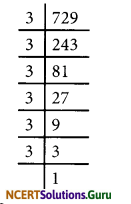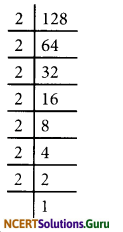These NCERT Solutions for Class 7 Maths Chapter 13 Exponents and Powers Ex 13.2 Questions and Answers are prepared by our highly skilled subject experts.
NCERT Solutions for Class 7 Maths Chapter 13 Exponents and Powers Exercise 13.3
Question 1.
Write the following numbers in the expanded forms:
279404, 3006194, 2806196, 120719, 20068
Answer:
(i) 279404
= 2 × 100000 + 7 x 10000 + 9 x 1000 + 4 x 100 + 0x10 + 4×1
= 2 × 105 + 7 × 104 + 9 × 103 + 4 × 102 + 0 × 10 + 4 × 1
= 2 × 105 + 7 × 104 + 9 × 103 + 4 × 102 + 4 × 100
(ii) 3006194
= 3 × 1000000 + 0 × 100000 + 0 × 10000 + 6 × 1000 + 1 × 100 + 9 × 10 + 4 × 1
= 3 × 106 + 0 × 105 + 0 × 104 + 6 × 103 + 1 × 102 + 9 × 101 + 4 × 100
= 3 × 106 + 6 × 103 + 1 × 102 + 9 × 101 + 4 × 100

(iii) 2806196
= 2 × 1000000 + 8 x 100000 + 0 x 10000 + 6 x 1000 + 1 x 100 + 9 x 10 + 6 x 1
= 2 × 106 + 8 × 105 + 0 × 104 + 6 × 103 + 1 × 102 + 9 × 101 + 6 × 100
= 2 × 106 + 8 × 105 + 6 × 103 + 1 × 102 + 9 × 10 + 6 × 100
(iv) 120719
= 1 × 100000 + 2 x 10000 + 0 x 1000 + 7 x 100 + 1 x 10 + 9 x 1
= 1 × 105 + 2 × 104 + 0 × 103 + 7 × 102 + 1 × 101 + 9 × 100
= 1 × 105 + 2 × 104 + 0 × 103 + 7 × 102 + 1 × 101 + 9 × 100
(v) 20068
= 2 × 10000 + 0 × 1000 + 0 × 100 + 6 × 10 + 8 × 1
= 2 × 104 + 0 × 103 + 0 × 102 + 6 × 101 + 8 × 100
= 2 × 104 + 0 × 103 + 0 × 102 + 6 × 101 + 8 × 100
Question 2.
Find the number from each of the following expanded forms:
(a) 8 × 104 + 6 × 103 + 0 × 102 + 4 × 101 + 5 × 100
(b) 4 × 105 + 5 × 103 + 3 × 102 + 2 × 100
(c) 3 × 104 + 7 × 102 + 5 × 100
(d) 9 × 105 + 2 × 102 + 3 × 101
Answer:
(a) 8 × 104 + 6 × 103 + 0 × 102 + 4 × 101 + 5 × 100
= 8 × 10000 + 6 × 1000 + 0 × 100 + 4 × 10 + 5 × 1
= 80000 + 6000 + 0 + 40 + 5 = 86045

(b) 4 × 105 + 5 × 103 + 3 × 102 + 2 × 100
= 4 × 100000 + 5 × 1000 + 3 × 100 + 2 × 1
= 400000 + 5000 + 300 + 2
= 405302
(c) 3 × 104 + 7 × 102 + 5 × 100
= 3 × 10000 + 7 × 100 + 5 × 1 = 30000 + 700 + 5 = 30705
(d) 9 × 105 + 2 × 102 + 3 × 101
= 9 × 100000 + 2 × 100 + 30
= 900230
Question 3.
Express the following numbers in standard form:
(i) 5,00,00,000
(ii) 70,00,000
(iii) 3,18,65,00,000
(iv) 3,90,878
(v) 39087.8
(vi) 3908.78
Answer:
(i) 5,00,00,000 = 5 × 100,00,000 = 5 × 107
(ii) 70,00,000 = 7 × 100,00,00 = 7 × 106
(iii) 3,18,65,00,000 = 3.1865 × 109
(iv) 3,90,878 = 3.90878 × 105
(v) 39087.8 = 3.90878 × 104
(vi) 3908.78 = 3.90875 × 103

Question 4.
Express the number appearing in the following statements in standard form.
(a) The distance between Earth and Moon is 384,000,000 m.
(b) Speed of light in vacuum is 300,0,000 m/s.
(c) Diameter of the Earth is 1,27,56,000 m.
(d) Diameterofthe Sunis 1,400,000,000 m.
(e) In a galaxy there are on an average 100.0.000.000 stars.
(f) The universe is estimated to be about 12.0.000.000 years old.
(g) The distance of the Sun from the centre of the Milky Way Galaxy is estimated to be 300,000,000,000,000,000,000 m.
(h) 60,230,000,000,000,000,000,000 molecules are contained in a drop of water weighing 1.8 gm.
(i) The Earth has 1,353,000,000 cubic km of sea water.
(j) The population of India was about 1.027.0. 000 in March, 2001.
Answer:
(a) 384,000,000 = 3.84 × 108
∴ The distance between earth and Moon
= 3.84 × 108 m.
(b) 300,000,000 = 3 × 108
∴ Speed of light in vacuum is = 3 × 108m/s.
(c) 1,27,56,000 = 1.2756 × 107
∴ Diameter of the Earth is = 1.2756 × 107 m.
(d) 1,400,000,000= 1.4 × 109
∴ The Diameter of the Sun = 1.4 × 1022 m.

(e) 100,000,000,000= 1 × 1011
∴ In a galaxy there are on an average = 1 × 1011 stars.
(f) 12,000,000,000 = 1.2 × 1010
∴ The universe is estimated to be about 1.2 × 1010 years old.
(g) 300,000,000,000,000,000,000 = 3 × 1020
∴ The distance of the Sun from the centre of the Milky
Way Galaxy is estimated to be = 3 × 1020 m
(h) 60,230,000,000,000,000,000,000 = 6.023 × 1022
6.023 × 1022 molecules are contained in a drop of water weighing 1.8 gm.
(i) 1,353,000,000= 1.353 × 109
∴ The Earth has 1.353 × 109 cubic km of sea water.
(j) 1,027,000,000= 1.027 × 109
∴ The population of India was about 1.027 × 109 in March, 2001.
![]()
![]()
![]()
![]()
















